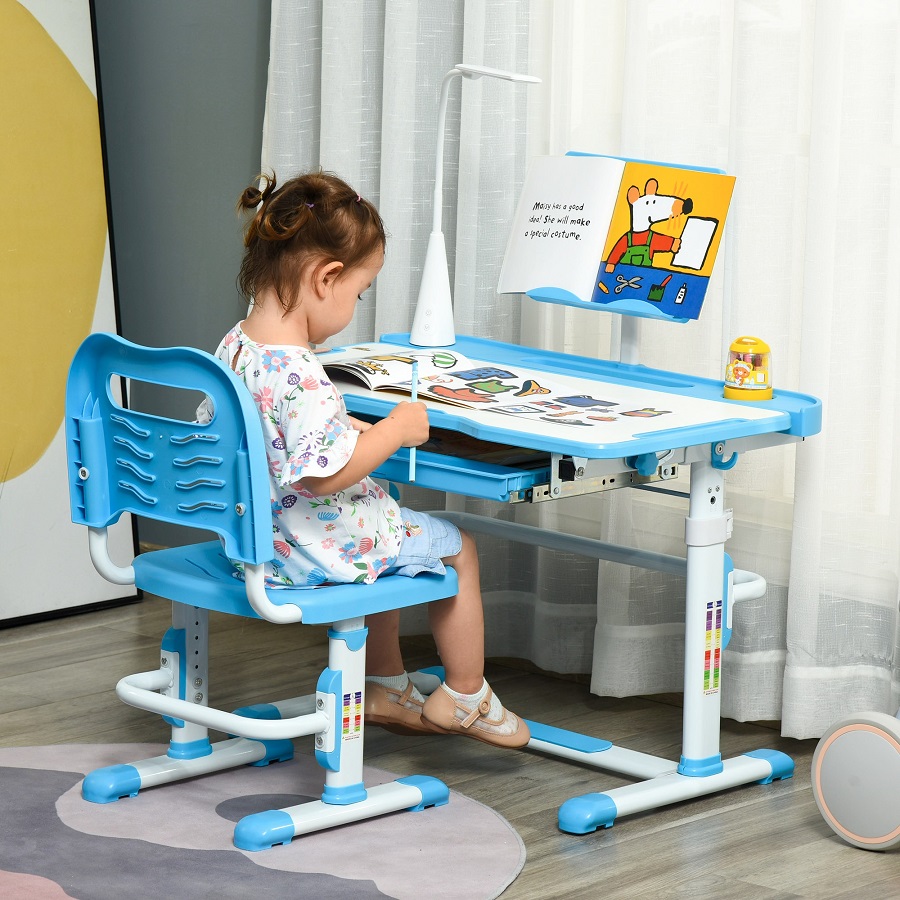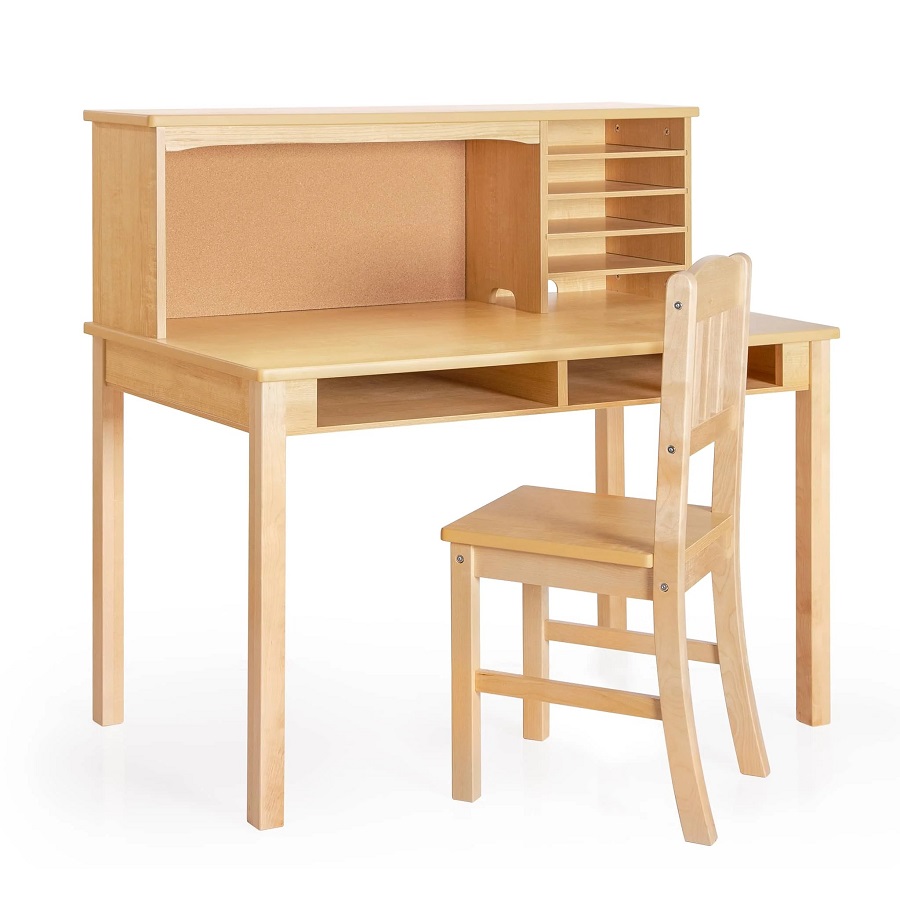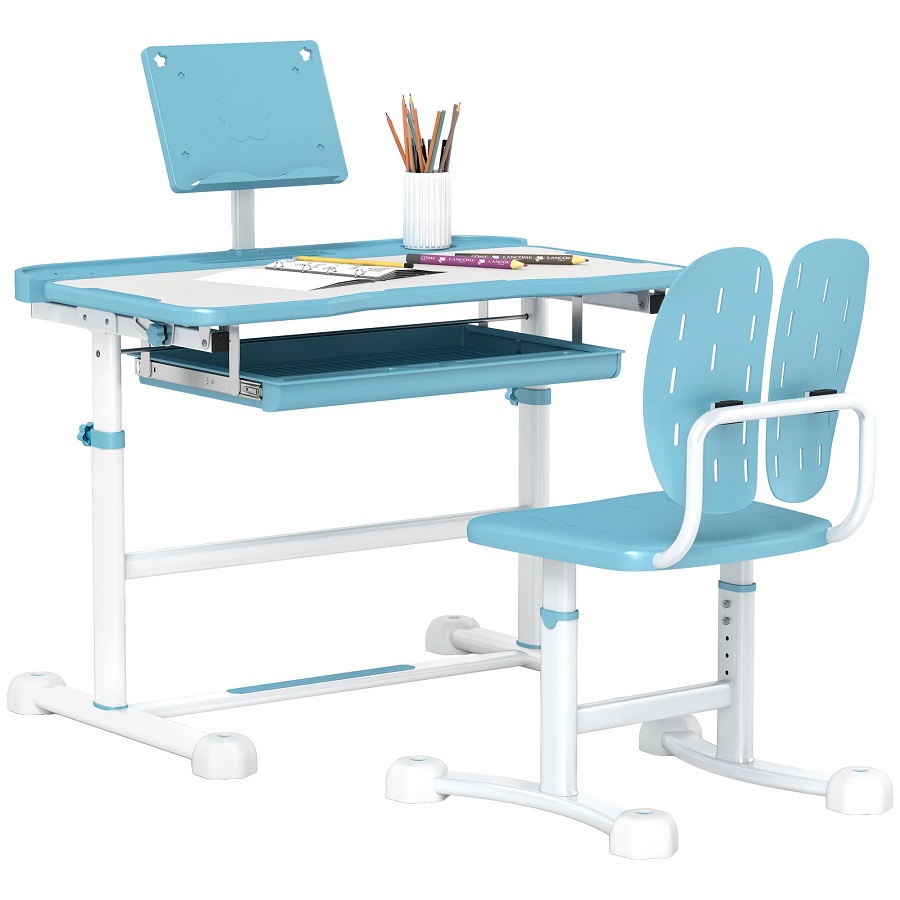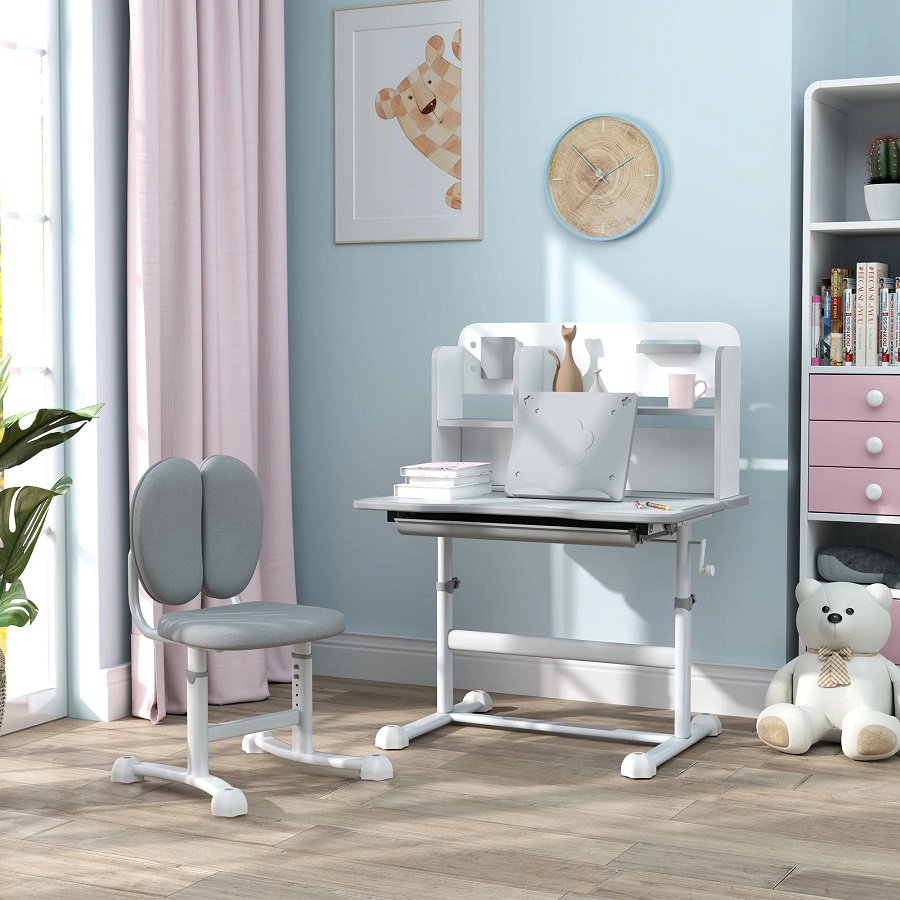Importance of Comfort and Ergonomics for Children
Ensuring comfort and ergonomics for children at their study space is crucial. A poorly designed kids school desk and chair can lead to discomfort and even health problems. Children are growing, and using furniture that doesn’t support their posture can cause issues like back pain and strain on the neck. Therefore, it’s essential to find a desk and chair set that suits their body size and encourages a healthy sitting position.
First, the chair should allow the child’s feet to rest flat on the ground. This prevents dangling legs that can reduce blood circulation. Second, the desk should be at an appropriate height so that the child’s arms can rest comfortably on it without hunching their shoulders. It’s ideal for their elbows to form a 90-degree angle when writing or typing.
An ergonomic setup promotes better focus and longer attention spans. Kids are more likely to enjoy learning and doing homework when they’re comfortable. Moreover, good habits formed early can last a lifetime. When choosing a kids school desk and chair, prioritize options that offer adjustable features. This allows the furniture to grow with your child and remain comfortable over time. A well-designed ergonomic desk and chair can also be a fun addition to a child’s room, showing them that their comfort is important and valued.

Key Features to Look for in a Kids School Desk
When shopping for a kids school desk and chair, certain features stand out as must-haves. Look for a desk that presents a blend of function and comfort. The key features include:
- Adjustable Height: This feature is vital for an ergonomic fit that grows with your child.
- Sturdy Construction: A well-built desk ensures safety and longevity. It should not wobble or tip easily.
- Smooth Edges: Rounded corners are safer for active kids who might bump into their desk.
- Appropriate Size: The desk should have enough space for books, papers, and a computer if needed.
- Easy-to-Clean Surface: Spills and stains are inevitable. A desk with a wipeable surface is practical.
- Cord Management: If technology is used, cord holes or hooks can keep cables tidy.
Selecting a kids school desk with these features helps create an optimal learning environment. It can make study time more enjoyable and less of a chore, leading to a more willing and engaged young learner.
How to Choose the Right Size of Desk and Chair for Your Child
Choosing the right size for a kids school desk and chair is not a one-size-fits-all task. A proper fit is essential for maintaining comfort and ensuring the ergonomics mentioned earlier. Here are some steps to find the ideal size:
- Measure Your Child: Take your child’s height and arm length measurements. This helps in selecting a chair where their feet rest flat and arms are at desk level.
- Consider Leg Room: There should be ample space under the desk for leg movement. Avoid cramping your child’s legs in a tight space.
- Desk Height: The desk should align with your child’s mid-chest level when seated. They shouldn’t have to reach up or bend down to write.
- Chair Height: When sitting, your child’s thighs should be parallel to the floor. Their knees should form a 90-degree angle.
- Test for Comfort: If possible, let your child test out the desk and chair for comfort. They should be able to sit back against the chair with their lower back supported.
By following these tips, you ensure that the kids school desk and chair you select promote a proper posture. This not only affects their comfort but can also impact their concentration and eagerness to study. Remember, the goal is to have a happy and healthy learner, eager to tackle their studies each day.
The Role of Adjustability in Kids Desks and Chairs
Adjustability in kids school desk and chair sets is key for their long-term use. As children grow, their furniture needs to adapt. An adjustable desk and chair can ensure that your child maintains good posture as they get taller. Here’s why adjustability is so critical:
- Grows with Your Child: A desk and chair that adjust in height can serve your child for many years.
- Supports Proper Posture: Adjustable furniture allows for the correct ergonomic positioning, preventing slouching or straining.
- Offers Value for Money: Instead of buying new furniture every few years, adjustable options last longer, saving you money.
- Encourages Independence: Kids can adjust their own desk and chair to fit them, which fosters a sense of ownership and responsibility.
When shopping for a kids school desk and chair, prioritize adjustable options. This could include desks with tiltable surfaces or chairs with height-adjustable seats and backrests. Seek out desks and chairs with easy-to-use mechanisms. This ensures that adjustments can be made quickly and safely, without the need for complex tools or adult intervention.
Remember: a desk and chair that grow with your child will contribute to their well-being and academic success. By choosing adjustable furniture, you’re investing in your child’s comfort, focus, and health.
Material Choices for Durability and Safety
When picking out a kids school desk and chair, the material plays a big role. It affects both the durability and safety of the furniture. Here are the materials you should consider:
- Solid Wood: This classic choice offers strength and longevity. Wood desks and chairs are sturdy and can handle wear and tear from daily use. However, ensure the wood is smooth and free of splinters to prevent injuries.
- Metal: Metal frames can provide solid support. They are often used for adjustable features and can give a modern look. Look for desks with rounded metal edges to keep your child safe.
- Plastic: A lightweight option suitable for younger kids. It’s easy to clean and comes in bright colors. Just make sure it’s a high-quality, toxin-free plastic.
- Laminate: Laminate surfaces are common for their resistance to stains and scratches. They’re perfect for easy cleaning and maintenance.
- MDF: Medium-density fiberboard is an affordable alternative to solid wood. It’s not as strong but can be a good temporary solution.
Make sure the materials used are non-toxic and meet safety standards. Avoid sharp edges or small parts that could be a choking hazard. Overall, your best bet is to choose materials that ensure the kids school desk and chair can withstand the inevitable bumps and spills, all while keeping your child out of harm’s way.

Style and Design Considerations for Young Students
When selecting a kids school desk and chair, style and design are more than mere aesthetics. They play a significant role in making the study area inviting and stimulating for young students. Here are some style and design considerations to keep in mind:
- Appealing Colors: Bright and cheerful colors can energize and motivate young minds. Choose a color that your child loves.
- Interactive Elements: Desks with interactive features like a dry-erase tabletop can encourage creativity.
- Personalization: Look for desks that allow kids to add their own touch, like space for stickers or photos.
- Theme Consistency: If your child’s room has a theme, like space or animals, match the desk and chair to this theme to create a cohesive look.
- Child-friendly Design: Opt for designs that speak to children’s interests and are proportionate to their size.
- Incorporate Their Input: Including your child in the decision process makes them feel valued and more likely to use their desk.
The right style and design can make a significant difference in how children perceive their study space. It should be a place they are excited to spend time in, sparking joy and curiosity each day. Keep in mind that the kids school desk and chair should blend functionality with fun, creating a perfect balance that facilitates learning and growth.
Additional Accessories and Storage Solutions
When creating the ideal study space for children, additional accessories, and storage solutions are key components for a kids school desk and chair set. These enhance functionality and help in maintaining an organized study environment. Here’s what to consider:
- Built-in Shelves: Look for desks with shelves that offer space for books and supplies.
- Desk Organizers: Portable trays or containers keep pens, pencils, and markers in order.
- Under-Desk Drawers: These can store workbooks and art materials, keeping the desk surface clear.
- Cable Management Systems: For tech-friendly study spaces, choose desks with built-in cable organizers.
- Adjustable Lamp: A good desk lamp can be positioned to reduce eye strain, a must-have for late-night studying.
- Ergonomic Accessories: Wrist rests and foot stands might be small, but they provide extra comfort.
- Bulletin Boards or Dry-Erase Boards: Installing these near the desk can help your child plan and stay organized.
The right storage solutions and accessories can change a basic kids’ school desk and chair into a complete learning station. They allow children to have everything they need within reach, which leads to fewer distractions and better study habits. Remember to include your child in the choice of these additional items; their personal touch can make all the difference in how they feel about their study space.

Best Practices for Setting Up a Productive Study Space at Home
Creating a productive study space for kids at home involves more than just a kids school desk and chair. It’s about setting up an environment that encourages learning and focus. Here are some best practices to consider when organizing a study space:
- Choose a Quiet Area: Identify a spot in the house that is away from high traffic and noise. A quiet corner is ideal for concentration.
- Proper Lighting: Make sure the area is well-lit. Natural light is best, but if that’s not possible, bright and effective artificial lighting will reduce eye strain.
- Minimize Distractions: Keep toys and electronics that are not related to study out of sight. This helps your child stay on task.
- Access to Resources: Place dictionaries, textbooks, and other learning materials close by. Easy access to resources supports seamless studying.
- Personalize the Space: Let your child help decorate the space. This can include their artwork or favorite colors. A personalized space can improve their mood and desire to study.
- Organize Regularly: Encourage your child to tidy their desk after each study session. A clutter-free desk promotes a clear mind.
- Comfortable Seating: Again, ergonomics is key. Ensure the chair supports your child’s posture. They should feel comfortable even after sitting for long periods.
- Set a Schedule: Establish a regular study time. Routines help children focus better and manage their time.
- Positive Reinforcement: Display their achievements, like good grades or completed projects, near the study area. This will boost their confidence and motivation.
By following these steps, you create a space that’s not just about homework. It’s a space where creativity, curiosity, and learning thrives, well-suited for your child’s educational journey. Always keep ‘kids school desk and chair’ at the core, but remember that the surroundings are equally important.
